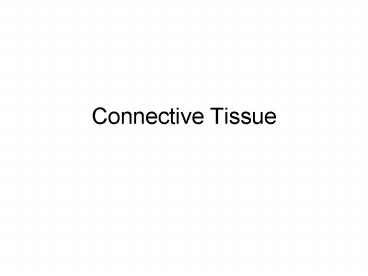Connective Tissue - PowerPoint PPT Presentation
1 / 26
Title:
Connective Tissue
Description:
1) Collagenous (White) - most common, appear white in the living state, composed ... of matrix); histamine (capillary permeability, allergic anaphylaxis) ... – PowerPoint PPT presentation
Number of Views:98
Avg rating:3.0/5.0
Title: Connective Tissue
1
Connective Tissue
2
Connective Tissue
- Forms fascias, capsules, sheaths, septa,
tendons, ligaments, basement membranes, bone,
blood, cartilage. - Functions
- a) connection and support
- b) Mononuclear Phagocytic System (MPS)
- c) temperature control
- d) nutrient distribution
- e) tissue repair, etc.
3
Anatomical Characteristics
- small number of total cells in tissues
- several different cell types.
- predominance of matrix and fibers
4
Fibers
- 1) Collagenous (White) - most common, appear
white in the living state, composed of 28 types. - Collagen makes up approx. 25 of the protein
which is approx. 20-25 of human body weight. - very inelastic, resists stretching
- Fibers 1 - 100 mm thick, most 1-10.
- Fibrils 0.5 mm thick
- Proto fibrils 10 100 nm
5
Collagen Fibers (100,000X)
6
secreted by fibroblasts
7
(No Transcript)
8
Collagen
- Congeals forming gelatin, digested by pepsin.
- Increases in quantity and distribution with age.
- Too little (e.g. Vitamin C Deficiency) scurvy.
- Too much arthritis several other disorders.
- Fibers occur in ligaments, tendons, skin, gel
forms in many matrices. - Types I, II, III, V, and XI form fibrils
- Others are non-fibroid, forms of ground substance
and bind collagen fibers, may be secreted by some
epithelia. - Type IV forms meshwork- basal lamina
9
Fibers
- Reticular Fibers- Collagen Type III, variant of
white fiber, but very thin 0.5 to 2 mm - Fibril diameter with cross striations every
- 64 nm
- Branches more than white fibers
- Strongly argyrophilic.
- Resists stretching.
10
Reticular Fibers- Adrenal Cortex
11
(No Transcript)
12
Fibers
- Elastic (Yellow) - larger than white, no
striations. - Some branching contains the protein elastin.
- Yellow and refractive when alive stretches 1.5 x
its resting length - Only 1/10 as strong as white.
- Usually occurs with white fibers.
- Secreted by fibroblasts and maybe by smooth
muscle cells
13
Fibers
- Pure elastic CT organs are the ligamentum flava,
suspensory ligament of the penis in humans, and
the ligamentum nuchae (neck ligament) of the ox. - Fibers exhibit poor organization with spaces
between - Stain selectively purple with orcein
14
(No Transcript)
15
Matrix (Ground Substance)
- Glycosaminoglycans (GAG)
- - repeated disaccharide units, one of which is a
- sulfated hexosamine. Unique example is
hyaluronic acid which is a non-sulfated GAG. - - Chondroitin SO4 (Collagen Type II)
- - Dermatan SO4 (Type I)
- - Keratan SO4 (no collagen),
- - Heparan SO4 (Type III, IV).
- Proteoglycans (PG) GAG chains bound to a
protein core. Matrix of cartilage.
16
Proteoglycan
Glycoprotein
17
Connective Tissue Cells
- Fixed and wandering (mobile)
- All derived ultimately from embryonic mesenchyme
18
Fibroblasts
- Fixed cells, secrete fibers and matrix
- Closely resemble mesenchyme cells many Golgi
many cytoplasmic processes 1-2 nucleoli a
large, light staining nucleus - May be pleuropotential decrease in number with
age the most common CT cell. - Fibrocyte less metabolically active. Mature
cells of tendons and ligaments. - Myofibroblasts - modified fibroblasts wound
repair and maybe some fiber secretion
19
(No Transcript)
20
(No Transcript)
21
Macrophages
- Originate from monocytes and/or hematopoetic stem
cells - Main phagocytic cell of CT
- - small, elongate, dark staining nucleus
- - cells sedentary or nomadic cosmopolitan
- - immunologic, antigen presenting cell (form
MHC) - Special Names in certain regions
- Kupffer cells in the liver
- Microglial Cells in CNS
- Langerhans Cell in Skin
22
Mast Cell
- Smaller cells (compared with macrophage) with
metachromatic cytoplasmic granules - Contain heparin (anticoagulant, prevents
hyaluronidase depolymerization of matrix)
histamine (capillary permeability, allergic
anaphylaxis). - Concentrated around capillaries.
- Functions primary mediator of the inflammatory
response. non-specific defense reaction - Can produce hypersensitivity (allergic reaction)
23
Mast Cell Activation Degranulation
24
(No Transcript)
25
Adipocyte
- Adipose (fat) tissue
- Normally 15-20 bw
- Unilocular yellow
- Multilocular - brown
26
(No Transcript)































